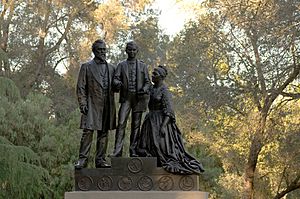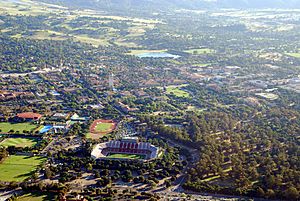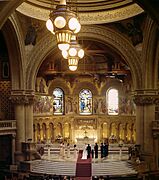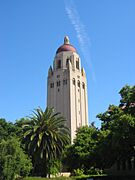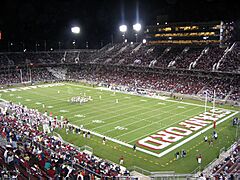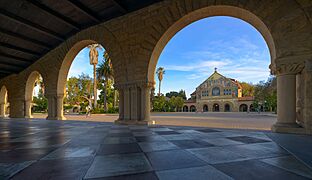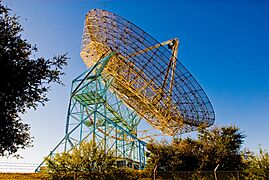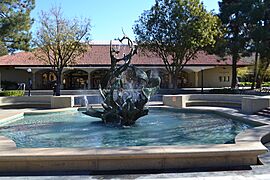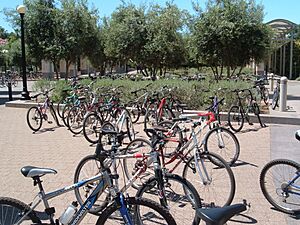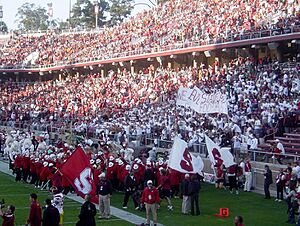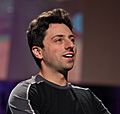Stanford University facts for kids
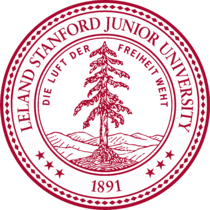 |
|
| Motto | Die Luft der Freiheit weht (German) |
|---|---|
|
Motto in English
|
"The wind of freedom blows" |
| Type | Private research university |
| Established | October 1, 1891 |
| Founder | Leland and Jane Stanford |
| Accreditation | WSCUC |
|
Academic affiliations
|
|
| Endowment | $36.5 billion (2023) |
| Budget | $8.9 billion (2023/24) |
| President | Jonathan Levin |
| Provost | Jenny Martinez |
|
Academic staff
|
2,323 (fall 2023) |
|
Administrative staff
|
18,369 (fall 2023) |
| Students | 17,529 (fall 2023) |
| Undergraduates | 7,841 (fall 2023) |
| Postgraduates | 9,688 (fall 2023) |
| Location |
,
United States 37°25′39″N 122°10′12″W / 37.42750°N 122.17000°W
|
| Campus | Large suburb: 8,180-acre (3,310-hectare) |
| Other campuses |
|
| Newspaper | The Stanford Daily |
| Colors | Cardinal Red White |
| Nickname | Cardinal |
|
Sporting affiliations
|
|
| Mascot | Stanford Tree (unofficial) |
Leland Stanford Junior University, usually called Stanford University, is a private research university. It is located in Stanford, California, in the United States. The university was started in 1885 by Leland Stanford and his wife, Jane Stanford. They founded it to honor their only child, Leland Stanford Jr., who had passed away.
Stanford welcomed its first students in 1891. It was open to both boys and girls and did not favor any specific religion. The university faced money problems after Leland Stanford died in 1893. It also suffered damage from the 1906 San Francisco earthquake. After World War II, a leader named Frederick Terman encouraged students to start their own businesses. This helped create Silicon Valley, a famous area for technology. In 1951, the Stanford Research Park opened. It was the world's first university research park.
The university has seven main schools of study. Its campus is huge, covering about 8,180 acres. This makes it one of the largest campuses in the country. Stanford is known for its high level of research. Students at Stanford compete in 36 different sports. The university has won 136 national team championships. Many students and alumni have also won Olympic medals, including 153 gold medals.
Stanford is connected to many successful people. This includes 94 billionaires and 58 Nobel Prize winners. It also has 29 Turing Award winners, who are like Nobel winners for computer science. Many alumni are also Fulbright Scholars and members of the United States Congress.
Contents
Stanford's Story
Stanford University was founded in 1885. It was a special way for Leland Stanford and Jane Stanford to remember their son, Leland Stanford Jr.. The university officially opened its doors in 1891. It was built on the Stanfords' old farm in Palo Alto.
Early Days and Design
Stanford was designed to be like big universities in the Eastern U.S. Many of its first teachers came from Cornell University. Both Cornell and Stanford were among the first to offer higher education to everyone. They were open to both women and men, and didn't focus on one religion.
The Stanfords wanted their buildings to look special. They wanted them to be like old Spanish adobe houses. These houses had thick walls, deep window seats, and red tile roofs. They also hired Frederick Law Olmsted, a famous landscape architect. He had also designed the Cornell campus.
Overcoming Challenges
When Leland Stanford died in 1893, the university faced financial trouble. But Jane Stanford made sure it stayed open. The 1906 San Francisco earthquake caused a lot of damage. Many buildings were repaired, but some parts of the Stanford Memorial Church were never fully restored.
In the early 1900s, Stanford added professional graduate schools. The Stanford University School of Medicine started in 1908. The Stanford Law School became a professional school in 1908. The Stanford University Graduate School of Education opened in 1917. The Stanford Graduate School of Business was founded in 1925.
Stanford and Silicon Valley
In the 1940s and 1950s, Frederick Terman encouraged Stanford engineering graduates to create new companies. He helped set up the Stanford Industrial Park. This park was a high-tech area on university land.
William Shockley, a Nobel Prize winner, moved to Palo Alto. He founded a company there. Later, some of his employees left to start Fairchild Semiconductor. The growth of these tech companies helped make Stanford and the surrounding area a hub for new ideas. This area became known as Silicon Valley.
Growth and Achievements
In the 1960s, Stanford became one of the top universities in the U.S. Wallace Sterling was president from 1949 to 1968. He helped Stanford grow from a small, struggling university to a world-famous one.
During his time, Stanford achieved many things:
- The Stanford Medical School moved to the main campus.
- The Stanford Research Park and Stanford Shopping Center were built. These helped the university's finances.
- More students received financial aid.
- The number of students and teachers greatly increased.
- Many new buildings were constructed on campus.
- The Overseas Campus program for students began in 1958.
Stanford's Land and Location
Stanford's main campus covers about 8,180 acres. It is one of the largest university campuses in the United States. It is located on the San Francisco Peninsula. This is about 37 miles southeast of San Francisco. It is also about 20 miles northwest of San Jose.
Much of Stanford's land is undeveloped. Some parts, like the Stanford Shopping Center, are within the city of Palo Alto. Other parts are in nearby counties and cities.
Campus Features
The central campus has a seasonal lake called Lake Lagunita. It is an irrigation reservoir and home to the California tiger salamander. Heavy rains in 2023 refilled the lake. Two other reservoirs, Searsville Lake and Felt Lake, are on more distant parts of the land.
Beyond the Main Campus
Stanford also owns other important areas:
- Jasper Ridge Biological Preserve: A 1,200-acre natural reserve. It is used by scientists to study wildlife and the natural Earth.
- SLAC National Accelerator Laboratory: A research facility operated by the university. It has the world's longest linear particle accelerator, which is 2 miles long.
- Hopkins Marine Station: Located in Pacific Grove, California. This is a marine biology research center. It is one of the oldest marine laboratories.
- Redwood City campus: This campus in Redwood City, California holds many of the university's administrative offices. It opened in 2019.
- The Bass Center: In Washington, D.C., this center provides a base for students studying in Washington.
- Stanford Center at Peking University: A small center in China for researchers and students.
Faculty Homes and Other Uses
Many Stanford teachers live in an area called the "Faculty Ghetto." These homes are on land owned by Stanford. Teachers can buy and sell these houses to other Stanford faculty.
Some of Stanford's land is used to make money for the university. This includes the Stanford Shopping Center and the Stanford Research Park. Stanford also leases land for local schools, like Palo Alto High School. The campus also has the Stanford Golf Course and the Stanford Red Barn Equestrian Center.
Famous Campus Spots
Stanford has many well-known landmarks:
- The Main Quad and Stanford Memorial Church.
- The Cantor Center for Visual Arts.
- Hoover Tower, a tall building on campus.
- The Rodin Sculpture Garden, with many famous statues.
- The Papua New Guinea Sculpture Garden, featuring unique wood carvings.
- Green Library, a large library building.
- The Dish, a large radio telescope on the hills.
- White Memorial Fountain (also called "The Claw") is a popular meeting spot. Students sometimes "fountain hop" by dipping their feet or swimming in the campus fountains.
-
Inside the Stanford Memorial Church.
-
Hoover Tower, the tallest building on campus.
How Stanford is Run
Stanford is a private, non-profit university. It is managed by a group called the board of trustees. These trustees oversee the university's operations and finances. They also look after the Stanford Research Park and the Stanford Shopping Center.
The board chooses a president to lead the university. The president manages the university's daily activities and finances. Jonathan Levin became the thirteenth president on August 1, 2024. The provost is the main academic and budget officer. Jenny Martinez became the fourteenth provost in October 2023.
Stanford has seven academic schools:
- Stanford University School of Humanities and Sciences
- Stanford University School of Engineering
- Stanford Doerr School of Sustainability
- Stanford Law School (graduate programs only)
- Stanford University School of Medicine (graduate programs only)
- Stanford University Graduate School of Education (graduate programs only)
- Stanford Graduate School of Business (graduate programs only)
Students have their own government called the Associated Students of Stanford University (ASSU). This group represents all students.
Money and Gifts
Stanford has a large amount of money called an endowment. As of August 2023, it was valued at $36.5 billion. This makes it one of the largest university endowments in the U.S. This money helps pay for about 22% of the university's costs.
Stanford has received many large donations over the years. Early leaders like Leland Stanford and Jane Stanford gave a lot of money. Later, alumni who started successful companies like Google (Sergey Brin and Larry Page) and Nike (Phil Knight) also gave big gifts.
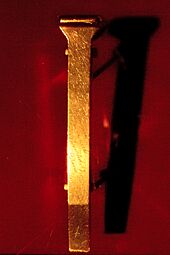
Learning at Stanford
Getting In
Stanford is known for being very selective. Only about 4% of applicants are accepted. Most accepted students have very high test scores. For example, their SAT scores are usually between 1440 and 1570. Their ACT scores are typically between 32 and 35. Good grades and strong recommendations are also very important.
Stanford tries to make sure that money is not a barrier for U.S. students. This is called "need-blind admission." This means they don't look at how much money a family has when deciding to admit a student. If a student needs financial help, Stanford provides it. For many families with lower incomes, tuition, room, and board are waived.
How Classes Work
Stanford uses a "quarter system." The autumn quarter usually starts in late September. The spring quarter ends in mid-June. The undergraduate program focuses on arts and sciences. Stanford is approved by the Western Association of Schools and Colleges.
Research and Innovation
Stanford is a top university for research. In 2021-2022, it spent $1.82 billion on research. The university has many research centers and institutes. These include the SLAC National Accelerator Laboratory and the Hoover Institution. Stanford also works with other universities on projects like the Biohub, which focuses on medical science.
Libraries and Resources
Stanford University Libraries (SUL) has 24 libraries. They hold over 9.3 million books and many digital resources. The main library is the Green Library. It has study spaces and reading rooms. The Hoover Institution Library and Archives focuses on 20th-century history.
Stanford also publishes the Stanford Encyclopedia of Philosophy. This is a leading online resource for philosophy.
Arts and Culture
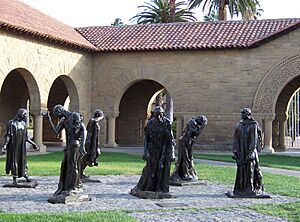
Stanford is home to the Cantor Center for Visual Arts. This museum has many galleries and sculpture gardens. It has one of the largest collections of works by Auguste Rodin in the world. This includes a famous bronze statue of The Thinker.
The university also has the Thomas Welton Stanford Gallery. In 2014, the Anderson Collection opened. It features postwar American art. There are also outdoor art installations, like the Papua New Guinea Sculpture Garden.
Stanford's music department has many groups, including choirs and orchestras. Students also enjoy theater groups and a cappella singing groups.
Reputation and Rankings
Stanford is consistently ranked as one of the best universities in the world. It is highly rated by U.S. News & World Report, Times Higher Education, and QS World University Rankings.
In 2022, Washington Monthly ranked Stanford as the #1 university in the U.S. Reuters has named Stanford the World's Most Innovative University for several years. The Stanford Graduate School of Business and Stanford Law School are also consistently ranked #1 in their fields.
The Princeton Review has often called Stanford the "dream college" for both students and parents. The Academic Ranking of World Universities (ARWU) usually ranks Stanford second in the world, after Harvard.
Discoveries and New Ideas
Stanford has been a place for many important discoveries and innovations.
Science Breakthroughs
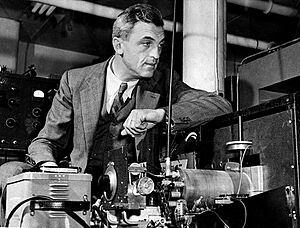
- DNA Synthesis: Arthur Kornberg discovered how deoxyribonucleic acid (DNA) is made. He won the Nobel Prize in Physiology or Medicine in 1959 for this work.
- First Transgenic Organism: Stanley Cohen and Herbert Boyer were the first to move genes from one living thing to another. This was a huge step for genetic engineering.
- Laser: Arthur Leonard Schawlow shared the Nobel Prize in Physics in 1981 for his work on lasers.
- MRI Principles: Felix Bloch developed methods for nuclear magnetic measurements. These are the basic ideas behind MRI.
Computer and Tech Innovations
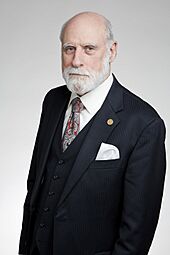
- ARPANET and the Internet: Stanford was a key place where the internet was first designed. Vint Cerf led a team that created the TCP/IP system. This system is the foundation of the internet.
- FM Synthesis: John Chowning invented the FM music synthesis algorithm in 1967. This technology was later used by Yamaha.
- Google: Larry Page and Sergey Brin started Google in 1996. They were PhD students at Stanford at the time. Google began as a research project to create a "universal digital library."
- Klystron Tube: The brothers Russell and Sigurd Varian invented the klystron tube at Stanford in 1937. This invention was important for radar equipment.
- RISC Processors: Stanford helped make RISC (Reduced Instruction Set Computing) microprocessors popular. The Stanford MIPS design became the successful MIPS architecture.
- SUN Workstation: Andy Bechtolsheim designed the SUN workstation at Stanford. This led to the company Sun Microsystems.
- MIMO: Arogyaswami Paulraj and Thomas Kailath invented MIMO radio communications in 1992. This technology uses multiple antennas and is essential for modern wireless devices.
Businesses and Startups
Stanford is known for helping students and teachers create new companies. Its Office of Technology Licensing helps turn university research into new products and businesses. Many students are encouraged to start their own companies.
Companies founded by Stanford alumni create over $2.7 trillion in yearly revenue. They have also created about 5.4 million jobs. If these companies were a country, they would have the tenth-largest economy in the world.
Some famous companies started by Stanford alumni or faculty include:
- Hewlett-Packard (1939): Co-founded by William R. Hewlett and David Packard.
- Sun Microsystems (1982): Co-founded by Vinod Khosla, Andy Bechtolsheim, and Scott McNealy.
- Cisco (1984): Co-founded by Leonard Bosack and Sandy Lerner.
- Nvidia (1993): Co-founded by Jensen Huang.
- Yahoo! (1994): Co-founded by Jerry Yang and David Filo.
- Netflix (1997): Co-founded by Reed Hastings.
- Google (1998): Co-founded by Larry Page and Sergey Brin.
- PayPal (1998): Co-founded by Ken Howery and Peter Thiel.
- LinkedIn (2002): Co-founded by Reid Hoffman.
- YouTube (2005): Co-founded by Jawed Karim.
- Instagram (2010): Co-founded by Kevin Systrom and Mike Krieger.
- Snapchat (2011): Co-founded by Evan Spiegel, Reggie Brown, and Bobby Murphy.
- Coursera (2012): Co-founded by Andrew Ng and Daphne Koller.
- DoorDash (2013): Co-founded by Tony Xu and Evan Moore.
Student Life at Stanford
Student Body
In the 2019–2020 school year, Stanford had about 7,000 undergraduate students and 10,000 graduate students. About half of the undergraduate students were women. Most freshmen (99%) continued their studies at Stanford. Many students also pursue a "coterminal degree," which means they earn a master's degree shortly after their bachelor's.
Where Students Live
Most undergraduate students (89%) live in university housing on campus. All first-year students must live on campus. Stanford guarantees housing for all four undergraduate years. Students live in many different types of homes, including dorms and co-ops.
Some residences are "theme" houses. These houses focus on specific interests like international cultures or human biology. Co-ops are houses where students work together to run the house, like cooking meals. These houses often have unique themes related to music, art, or philosophy.
Sports and Teams
Stanford has many sports teams. There are 16 male varsity sports and 20 female varsity sports. The university's team name is the "Cardinal". This refers to the color red, not the bird. The Stanford Tree is the unofficial mascot. It is known for being unique and sometimes controversial.
From 1930 to 1972, Stanford's teams were called the "Indians." This name and mascot were removed in 1972 after Native American students raised concerns. The university then went back to using "Cardinal" as its team name.
Stanford's main sports rival is the University of California, Berkeley. Their annual football game is called the "Big Game." The winner gets to keep the Stanford Axe.
Stanford has won more NCAA team championships (136) than any other school. Stanford has won at least one NCAA team championship every year for 48 years in a row. Stanford athletes have also won many Olympic medals. At the 2020 Tokyo Summer Olympics, Stanford-affiliated athletes won 26 medals.
Traditions
Stanford has many fun traditions:
- "Hail, Stanford, Hail!": This is the university's official song.
- Big Game: The exciting football rivalry against UC Berkeley.
- The Stanford Axe: A trophy exchanged between Stanford and Berkeley after the Big Game.
- Full Moon on the Quad: An annual event where students gather to kiss at midnight.
- Fountain Hopping: Students visit and sometimes swim in the university's 25 fountains.
- Mausoleum Party: An annual Halloween party at the Stanford Mausoleum.
- Wacky Walk: At graduation, students wear funny costumes as they enter the stadium.
- Band Run: At the start of the school year, the band picks up freshmen from dorms and performs.
- Viennese Ball: A formal dance with waltzes.
- "Die Luft der Freiheit weht": This is Stanford's unofficial motto, meaning "The wind of freedom blows." It became official in 2002.
Religious Life
Stanford welcomes students and staff of all religions. The Office for Religious Life helps guide and support spiritual life on campus. Stanford Memorial Church holds Sunday services and is used by various Christian groups. There is also a center for inter-religious community.
Student Groups
Stanford has over 600 student organizations. These groups cover many interests, like sports, community service, arts, and politics. All recognized student clubs are open for interested students to join.
Some notable student groups include:
- The Stanford Daily: The student-run daily newspaper, published since 1892.
- KZSU Stanford 90.1 FM: The student-run radio station.
- Business Association of Stanford Entrepreneurial Students (BASES): One of the largest professional groups in Silicon Valley. It helps students become entrepreneurs.
- StartX: A non-profit group that helps student and faculty startups.
- Stanford American Indian Organization (SAIO): Hosts the annual Stanford Powwow, the largest student-run powwow in the country.
- The Stanford Improvisors (SImps): Teach and perform improvisational theater.
Notable People
Stanford has many famous alumni and faculty members.
Award Winners and Scholars
Stanford's community includes many award winners:
- 58 Nobel Prize winners.
- 29 Turing Award winners (like the Nobel Prize for computer science).
- 33 MacArthur Fellows.
- 4 Pulitzer Prize winners.
- Many members of important national academies.
Stanford alumni have started many successful companies. According to Forbes, Stanford has produced the second-highest number of billionaires among all universities. Many Stanford students and alumni have also been named Rhodes Scholars.
- Notable Stanford alumni include:
-
Herbert Hoover (BS 1895), former President of the United States.
-
.
William Rehnquist (BA 1948, MA 1948, LLB 1952), former Chief Justice of the United States.
-
Sandra Day O'Connor (BA 1950, LLB 1952), former Associate Justice of the Supreme Court of the United States.
-
Rishi Sunak (MBA 2006), former Prime Minister of the United Kingdom.
-
Yukio Hatoyama (PhD 1976), former Prime Minister of Japan.
-
Stephen Breyer (BA 1959), former Associate Justice of the Supreme Court of the United States.
-
Larry Page (MS 1998), founder of Alphabet Inc..
-
Sergey Brin (MS 1995), founder of Alphabet Inc..
-
Reed Hastings (MS 1988), founder of Netflix Inc..
-
Phil Knight (MBA 1962), founder of Nike Inc..
-
Reid Hoffman (BS 1990), founder of LinkedIn Corporation.
- Notable present and past Stanford faculty include:
See also
 In Spanish: Universidad Stanford para niños
In Spanish: Universidad Stanford para niños
- List of universities by number of billionaire alumni
- List of colleges and universities in California
- S* – a collaboration between seven universities and the Karolinska Institute for training in bioinformatics and genomics
- Stanford School


